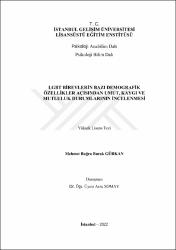LGBT bireylerin bazı demografik özellikler açısından umut, kaygı ve mutluluk durumlarının incelenmesi
Abstract
Amaç: Bu araştırmada LGBT bireylerin bazı demografik özellikler açısından umut, kaygı ve mutluluk durumlarının incelenmesi ve istatistiksel olarak değerlendirilmesi amaçlanmıştır. Umudu, kaygıyı ve mutluluğu etkileyen; cinsiyet, yaş, eğitim, cinsel eğilim ve kimlik, ilişki durumları, sosyal çevre ve statü, sosyo-ekonomik durum, ebeveyn tutumları gibi bazı demografik özellikler bağlamında, LGBT bireylerde umut, kaygı ve mutluluk puanları incelenmiştir. Yöntem: Araştırma grubu İstanbul ilinde ikamet eden on sekiz yaş ve üzeri 103 gönüllü LGBT bireylerinden oluşmuştur. Bu araştırmada kullanılan ölçekler "Oxford Mutluluk Ölçeği'', "Beck Umutsuzluk Ölçeği", "Beck Anksiyete Ölçeği", "Lezbiyen Gey Biseksüel Kimlik Ölçeği" ile araştırmacı tarafından hazırlanan "LGBT Kişisel Bilgi Formu" ve "Heteroseksüel Kişisel Bilgi Formu" yüz yüze olarak uygulanmıştır. LGBT ve Heteroseksüel bireylerin umut, anksiyete ve mutluluk durumlarının karşılaştırılması yapılmış olup yöntem bölümünde de konuyla ilgili detaylı bilgi verilmiştir. Elde edilen verilerin istatistik analizi yapılırken "Statistical Package For The Social Sciences" (SPSS) 25 paket programı kullanılmış ve analiz edilmiştir. Veri analizlerinde güven aralığı olan %95 düzeyine göre yapılmıştır. İstatistiksel olarak p<0,05 değeri anlamlılık düzeyi kabul edilmiştir. Analizlerde "T-testi, Mann-Whitney U Testi, Anova Analiz, Kruskal Wallis H Testi ve Spearman's Korelasyon Analizi" kullanılmıştır. Bulgular: Yapılan analizler neticesinde LGBT bireylerin umut, kaygı ve mutluluk durumlarında ilişki durumları, eğitim durumları, geleceğe bakış açıları ve sosyal dışlanma durumları gibi bazı demografik değişkenlere göre anlamlı farklılık olduğu, medeni durumları, psikolojik destek alma durumları, sahte evlilik yapma gibi bazı değişkenlere göre anlamlı farklılık olmadığı görülmüştür. LGB bireylerine uygulanan LGB Kimlik Ölçeği alt boyutlarına göre yine cinsel yönelimleri, ilişki durumları, eğitim ve gelir düzeyleri gibi bazı demografik değişkenlerde anlamlı farklılık olduğu, yaşam biçimleri ve aile yaklaşımı gibi bazı değişkenlerde ise anlamlı farklılık olmadığı görülmüştür. Bazı demografik özelliklere göre hem umutsuzluk, anksiyete ve mutluluk düzeylerinde farklılaşma olduğu gibi bazı değişkenlerde ise sadece mutluluk, anksiyete ve umutsuzluğun farklılaştığı ve/veya farklılaşmadığı görülmüştür. LGBT ve heteroseksüel bireylerin karşılaştırma analizinde mutluluk düzeylerinde anlamlı farklılık olduğu görülmüştür. Umutsuzluk ve anksiyete durumlarında ise anlamlı farklılık olmadığı görülmüştür. Sonuçlar: Araştırma sonucunda LGBT bireylerin ilişki durumları, yaşam biçimleri, aile yaklaşımları, geleceğe dair plan yapmaları, psikolojik destek almayı düşünmeleri ve hormon tedavisi görme durumları gibi değişkenlerde umutsuzluk, anksiyete ve mutluluk düzeylerinin yüksek olduğu görülmüştür. Lezbiyen Gey Biseksüel Kimlik Ölçeğinin alt boyutlarının demografik değişkenler ile yapılan analizlerde ise sorulan demografik soruların alt boyutlar ile tutarlı ve anlamlı farklılıklar olduğu görülmüştür. Yapılan görüşmeler sonucunda, LGBT bireylerin demografik sorulara verdikleri cevaplar ile umutsuzluk, anksiyete ve mutluluk düzeylerinin birbiri ile bağlantılı olduğu sonucuna varılmıştır. Korelasyon analizinde umut, kaygı ve mutluluk durumları arasında negatif ve pozitif ilişkiler görülmüştür. Purpose: In this study, it was aimed to examine and statistically evaluate hope, anxiety and happiness of LGBT individuals in terms of some demographic characteristics. Affecting hope, anxiety and happiness; In the context of various demographic characteristics such as gender, age, education, sexual orientation and identity, relationship status, social environment and status, socio-economic status, parental attitudes were examined for LGBT individuals regarding scores of hope, anxiety and happiness. Method: The research group consisted of 103 volunteer LGBT individuals aged eighteen and older residing in Istanbul. The scales used in this study were "Oxford Happiness Scale", "Beck Hopelessness Scale", "Beck Anxiety Scale", "Lesbian Gay Bisexual Identity Scale" and "LGBT Personal Information Form" and "Heterosexual Personal Information Form" prepared by the researcher. A comparison of hope, anxiety and happiness states of LGBT and Heterosexual individuals was made, detailed information on the subject is given in the method section. Statistical analysis of the data obtained was accomplished by "Statistical Package For The Social Sciences" (SPSS) 25 package program. Data analyzes were made according to the 95% confidence interval. Statistically, p<0.05 was accepted as the level of significance. "T-test, Mann-Whitney U Test, Anova Analysis, Kruskal Wallis H Test and Spearman's Correlation Analysis" were used in the analysis. Findings: As a result of the analyzes, there was a significant difference in the hope, anxiety and happiness status of LGBT individuals according to some demographic variables such as relationship status, educational status, perspectives on the future and social exclusion, and according to some variables such as marital status, receiving psychological support, fake marriage no significant difference was found. According to the LGB Identity Scale sub-dimensions applied to LGB individuals, it was observed that there was a significant difference in some demographic variables such as their sexual orientation, relationship status, education and income levels, while there was no significant difference in some variables such as lifestyles and family approach. According to some demographic characteristics, there was a differentiation in hopelessness, anxiety and happiness levels, while in some variables only happiness, anxiety and hopelessness differed and/or did not differ. In the comparison analysis of LGBT and heterosexual individuals, it was observed that there was a significant difference in their happiness levels. It was observed that there was no significant difference in hopelessness and anxiety states. Results: As a result of the research, it was seen that the levels of hopelessness, anxiety and happiness of LGBT individuals were high in variables such as their relationship status, lifestyle, family approaches, planning for the future, thinking about receiving psychological support and receiving hormone therapy. In the analyzes made with demographic variables of the sub-dimensions of the Lesbian Gay Bisexual Identity Scale, it was seen that the demographic questions asked were consistent and significant differences was found wih the sub-dimensions. As a result of the interviews, it was concluded that the answers given by LGBT individuals to the demographic questions and the levels of hopelessness, anxiety and happiness are related to each other. In the correlation analysis, negative and positive relationships were observed between the states of hope, anxiety and happiness.
Collections
- Yüksek Lisans Tezleri [1219]
The following license files are associated with this item:


















